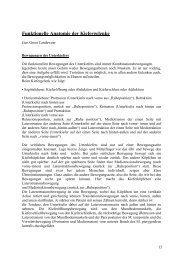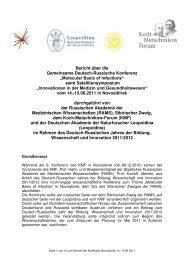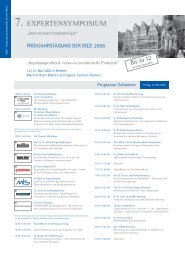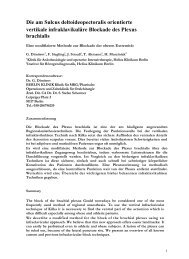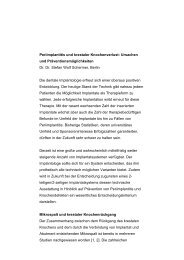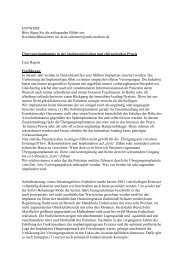NEWSLETTER AKFOS (2008) Jahr 15: No.1 - Berlin Klinik
NEWSLETTER AKFOS (2008) Jahr 15: No.1 - Berlin Klinik
NEWSLETTER AKFOS (2008) Jahr 15: No.1 - Berlin Klinik
Erfolgreiche ePaper selbst erstellen
Machen Sie aus Ihren PDF Publikationen ein blätterbares Flipbook mit unserer einzigartigen Google optimierten e-Paper Software.
- Alveolitis simplex<br />
- Osteomyelitis, Osteoradionekrose<br />
- Eröffnete Kieferhöhle<br />
- Kieferfraktur<br />
- KFO Extraktionen<br />
- Persistierende Milchzähne, Nichtanlage bleibender Zähne<br />
- Füllungsmaterialreste in der Wunde<br />
Kontaktadresse:<br />
DR. MED. DENT. HANS-PETER KIRSCH,, WEISSENBURGER STR. 60, 66113 SAARBRÜCKEN,<br />
Bite mark analysis in forensic routine case work<br />
R. Lessig, V. Wenzel and M. Weber<br />
This paper is dedicated to Prof. Dr. W. J. Kleemann, the former director of<br />
the Institute of Legal Medicine of the University of Leipzig, who died at the<br />
22 nd of February 2006<br />
INTRODUCTION<br />
The forensic odonto-stomatological investigation of bite marks is rare among the<br />
routine casework in forensic sciences. The term 'bite mark' is used in this field<br />
knowing that the marks are the result of the tooth impression in different materials.<br />
So in the literature bite mark is mostly used as description (Barbenel and Evans<br />
1977, Aboshi et al. 1994, Ligthelm and van Niekerk 1994, Saglam et al. 1998, Bernitz<br />
et al. 2000, McKenna et al. 2000, Sakoda et al. 2000, Pretty and Sweet 2001a, Pretty<br />
and Sweet 2001b, Pretty and Turnbull 2001, Sheasby and MacDonald 2001, Wright<br />
and Dailey 2001, Rötzscher et al. 2003, Thali et al. 2003). The state of the dentition,<br />
the degree of breakdown and/or repair of the teeth may create a bite mark with a<br />
high level of individuality. In some cases, bite marks may allow an identification of<br />
the biter (Ligthelm and van Niekerk 1994, Saglam et al. 1998, Lessig and Benthaus<br />
2003). Most bite marks are obtained from cases of sexual violence. Some may be<br />
defensive bites placed on the attacker by the victim, and, though rarely seen, some<br />
bite marks may be self-inflicted.<br />
Generally, bite marks consist of superficial abrasion, and/or sub-surface<br />
haemorrhage, or bruising of the skin because of the bite (Endris 1979). Though the<br />
mechanism is not clearly understood, the pattern of the injury is affected by the<br />
force and length in time of the bite, in combination with other mechanical and<br />
physiologic factors. Barbenel and Evans (1977) have discussed the influence of the<br />
lineages of the skin.<br />
Bite marks can be found in cases of sexual violence in typical areas of the human<br />
body – genitals and breasts -, but also in cases of child abuse. In such cases the<br />
number of the bites obtained can be very high. Trube-Becker (1973) reported a case<br />
with 17 bite marks.<br />
Occasionally bite marks are obtained in various types of food like chocolate, chewing<br />
gum, fruits, vegetables and similar (Endris 1979, Saglam et al. 1998, McKenna et al.<br />
21



